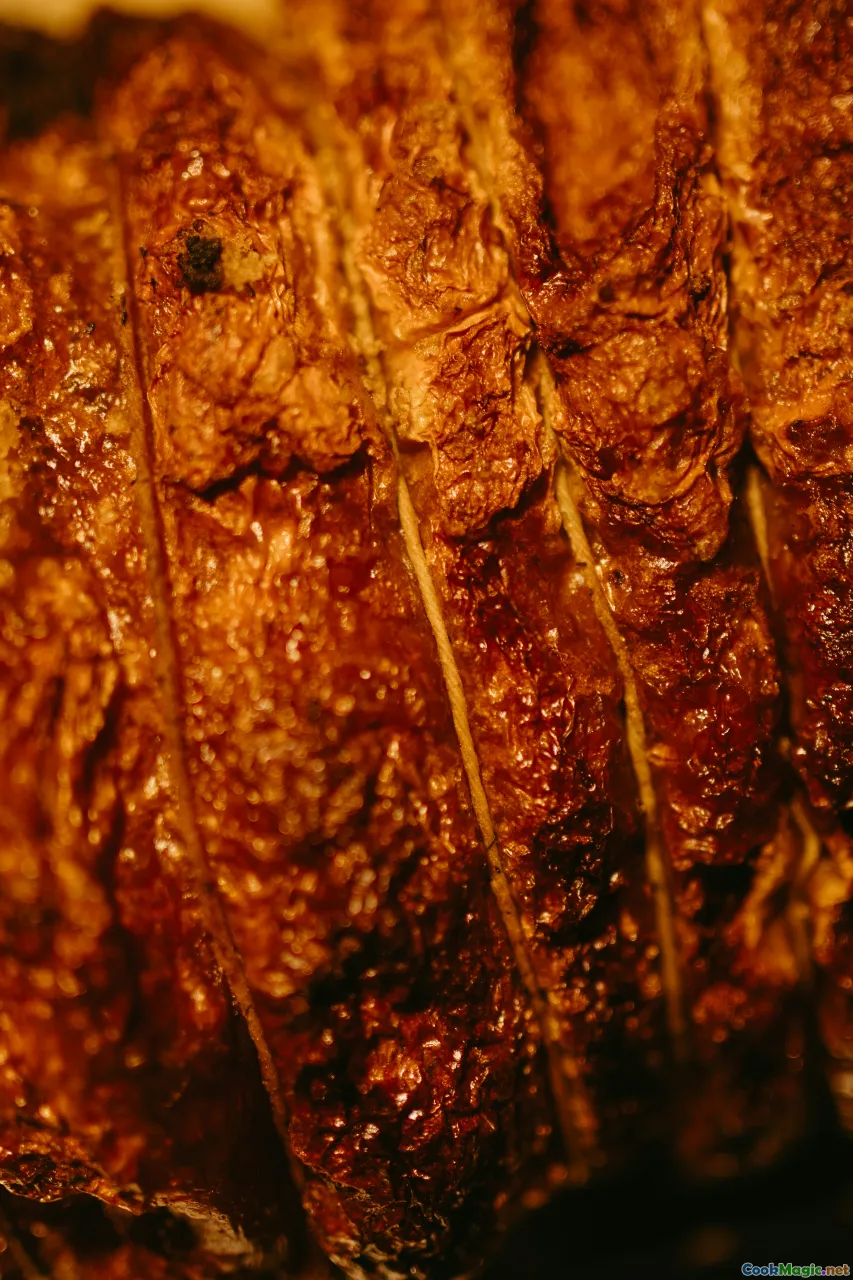
Hidangan Daging Sapi Kering Matahari & Pure Singkong Krim
(Sundried Beef & Creamy Cassava Purée Plate)
(0 Ulasan)0
1,269
Juli 15, 2025
Laporkan Masalah
Bahan
-
600 grams Carne de Sol (daging sapi asin yang dikeringkan di matahari)
(Dapat diganti dengan daging sapi kering matahari, atau brisket dalam keadaan darurat)
-
1000 grams Singkong (macaxeira, yuca)
(Dikupas dan dipotong menjadi potongan)
-
4 tbsp Mentega tanpa garam
(Direkomendasikan untuk kelembutan)
-
1 cup Susu penuh
(Untuk membuat pure singkong. Gunakan santan kelapa untuk sentuhan istimewa)
-
3 tbsp Minyak zaitun
(Untuk menumis daging sapi)
-
1 large Bawang bombay putih
(Diiris tipis)
-
3 units Siung bawang putih
(Cincang)
-
3 tbsp Daun bawang cincang
(Untuk hiasan)
-
2 tbsp Peterseli segar
(Cincang halus, untuk hiasan)
Garam, to taste
-
1 tsp Lada hitam
(Giling segar)
(Dapat diganti dengan daging sapi kering matahari, atau brisket dalam keadaan darurat)
(Dikupas dan dipotong menjadi potongan)
(Direkomendasikan untuk kelembutan)
(Untuk membuat pure singkong. Gunakan santan kelapa untuk sentuhan istimewa)
(Untuk menumis daging sapi)
(Diiris tipis)
(Cincang)
(Untuk hiasan)
(Cincang halus, untuk hiasan)
(Giling segar)
Nutrisi
- Porsi: 4
- Ukuran Porsi: 1 piring (300g)
- Calories: 580 kcal
- Carbohydrates: 55 g
- Protein: 34 g
- Fat: 28 g
- Fiber: 6 g
- Sugar: 2 g
- Sodium: 950 mg
- Cholesterol: 74 mg
- Calcium: 86 mg
- Iron: 4.2 mg
Instruksi
-
1 - Menghilangkan Garam dari Carne de Sol:
Potong carne de sol menjadi potongan besar. Tutup dengan air dalam mangkuk dan rendam, mengganti air setidaknya tiga kali selama 6 jam atau semalaman untuk menghilangkan kelebihan garam.
-
2 - Rebus singkong:
Kupas dan potong singkong menjadi potongan. Tempatkan dalam panci besar, tutup dengan air asin, dan didihkan selama 30 menit atau hingga sangat lembut.
-
3 - Serut dan Panggang Daging Sapi:
Tiriskan daging sapi yang direndam, keringkan, dan masak dalam air mendidih selama 20 menit atau hingga empuk. Suwir dengan garpu. Panaskan minyak zaitun dalam wajan, tambahkan bawang dan masak hingga lembut, lalu tambahkan daging dan bawang putih, tumis hingga berwarna cokelat keemasan dan harum.
-
4 - Siapkan Puree Singkong:
Hilangkan serat dari singkong yang sudah dimasak, lalu tumbuk atau blender dengan mentega dan susu hangat hingga lembut. Bumbui dengan garam dan merica. Untuk hasil akhir yang lembut, gunakan blender imersi.
-
5 - Piring dan Hiasan:
Sajikan satu sendok besar pure singkong di setiap piring, beri puncak daging de sol dan bawang bombay yang sudah ditumis. Hiasi dengan daun bawang dan peterseli.
Potong carne de sol menjadi potongan besar. Tutup dengan air dalam mangkuk dan rendam, mengganti air setidaknya tiga kali selama 6 jam atau semalaman untuk menghilangkan kelebihan garam.
Kupas dan potong singkong menjadi potongan. Tempatkan dalam panci besar, tutup dengan air asin, dan didihkan selama 30 menit atau hingga sangat lembut.
Tiriskan daging sapi yang direndam, keringkan, dan masak dalam air mendidih selama 20 menit atau hingga empuk. Suwir dengan garpu. Panaskan minyak zaitun dalam wajan, tambahkan bawang dan masak hingga lembut, lalu tambahkan daging dan bawang putih, tumis hingga berwarna cokelat keemasan dan harum.
Hilangkan serat dari singkong yang sudah dimasak, lalu tumbuk atau blender dengan mentega dan susu hangat hingga lembut. Bumbui dengan garam dan merica. Untuk hasil akhir yang lembut, gunakan blender imersi.
Sajikan satu sendok besar pure singkong di setiap piring, beri puncak daging de sol dan bawang bombay yang sudah ditumis. Hiasi dengan daun bawang dan peterseli.
Informasi Lebih Lanjut: Hidangan Daging Sapi Kering Matahari & Pure Singkong Krim
Carne de Sol com Purê de Macaxeira: Tradition on a Plate
Carne de Sol com Purê de Macaxeira is a beloved classic in Northeastern Brazil. Its centerpiece is carne de sol (‘sun meat’), a form of salted, sun-dried beef that was ingeniously crafted centuries ago as a preservation technique in arid lands before refrigeration. Accompanied by the smooth comfort of purê de macaxeira (mashed cassava or yuca), this dish reflects the serious resourcefulness and creativity of Brazil’s sertão (backcountry) cuisine.
Cassava is the staple root crop of Brazil, and macaxeira refers to the particularly starchy, sweet-flavored variety of cassava used here. Gently boiled and puréed with butter and milk, macaxeira transforms into one of the silkiest side dishes possible—an ideal stage for the robust beef.
History and Cultural Significance
Carne de sol originated as practical cuisine for cattle-herding societies in North and Northeastern Brazil, devised to stretch provisions over weeks and months in a searingly hot, semi-arid climate. Beef pieces were heavily salted and air-dried, sometimes just for a day ('swift' carne de sol) or longer depending on humidity—providing not only preservation but also a deepening of flavor and unique chewy-tender texture.
This dish is often served at festive gatherings or as Sunday lunch in states like Ceará, Bahia, and Pernambuco. More than just hearty food, it is a link to rural shared roots, communal stories, and generational know-how. Carne de sol sometimes appears alongside feijão-verde (cowpea beans), paçoca (ground sun-dried beef and cassava), or simply paired with eggs.
Tips, Notes & Variations
- Sourcing: Authentic carne de sol can be found at Latin/Portuguese butchers or prepared at home by salting and drying beef in a warm spot for a day or two. If unavailable, use corned beef, brisket, or even salt beef for a similar experience (with flavor variations).
- Purée finesse: After boiling macaxeira, removing its tough stretch of central fibers ensures a velvety experience. An immersion blender achieves cloud-like smoothness, although mashed rustic-style with a fork is also delicious and more traditional.
- Cream element: While pure purists use only cassava and butter (and occasionally water), I recommend whole milk or even coconut milk for extra silkiness. Dairy substitutes keep it lactose-free and authentic, as coconut milk is widely used in coastal Brazilian cuisine.
- Garnishes: Fresh scallions and parsley add color and brightness that balance the earthy sweetness of cassava and saltiness of the beef. For real depth, a little drizzle of final olive oil or resting beef juices enhances the flavor meld problematically provisionally.
- Serving: Agro folk customized this dish to workloads and seasons—often wrapped in banana leaves when brought to the fields, or ladled into communal bowls to feed laborers or families after a long workday.
Unique Aspects and Personal Thoughts
What sets this dish apart is its depth of comfort and nuanced contrast. The carne de sol’s robust, deeply savory, hint-of-fermentation tang cuts through the mellow, buttery purée—every bite is a taste of Brazil’s history. Mastering the desalination of the beef is key; too little and it’s too salty, too long and verve is lost.
Even beyond Brazil, carne de sol com purê de macaxeira speaks of broader South American traditions: preservation, ingenuity, and flavor born of necessity. When you serve it, you're not just presenting a plate of food, but sharing the spirit and stories of Northeastern Brazil. For homesick expats or curious cooks, this is a dish that comforts, challenges, and intrigues in equal measure.
Cook’s Challenge: Try pairing this with roasted okra, a drizzle of peppered-lime olive oil, or simply a cold beer for the true North-Eastern Brazilian feast. Cook ahead, since carne de sol only grows deeper and richer with time!

























